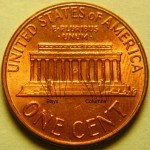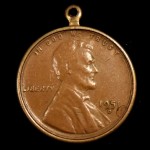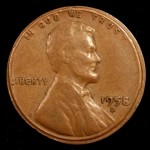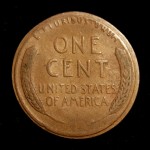A • B • C • D • E • F • G • H • I • J • K • L
M • N • O • P • Q-R • S • T • U • V • W • X-Z
Welcome to the Lincoln Cent Forum Glossary.
Use the alphabetical links above to navigate to the desired term.
This glossary of terms was written and compiled by Will Brooks with the help of our forum members. A huge thanks to everyone who contributed knowledge, ideas, words, and photos to make this growing educational resource possible. Special thanks to Richard Cooper, aka “Coop” who donated many of the photos.
Bag Mark: A hit to a coin by another coin as they are poured into a mint bag. This is a type of post-strike damage that occurs at the mint.
Bay: Counting from left to right, these refer to the spaces between the columns of the memorial building on the reverse of a memorial cent. There are 11 bays and 12 columns.

Bezel: A (usually) metal holder used in jewelry to hold a disc-shaped object such as a coin or medallion. These often will cause permanent damage to the rim of the coin when tightened down around the coin. When these coins are released from their bezels, their rims will exhibit this damage. See also Encased Cent. Photos courtesy of forum member mrmike916.



BIE: A die chip that develops between the B and E of LIBERTY, which often resembles a letter I, hence the name. This particular spot is a weak spot in the die and chronic die over-use in the 1950s produced many of these die chips.

Birth and Early Childhood in Kentucky: The first of four reverse design variations on 2009 Lincoln cents made to commemorate its 100th anniversary. This is also known as LP-1. This reverse was designed by Richard Master and sculpted by Jim Licaretz.

Blakesley Effect: Weakness in the rim area directly across from the “clip” on a clipped planchet. The absence of the clipped part of the planchet prevents the rim area across from the clip from being fully formed in the upset mill. This is because where the metal is missing, the upset mill has nothing to push against to create a full rim on the opposing end of the coin.


Blank (type 1 and type 2): Sometimes erroneously called a type 1 planchet, a blank is a circular disc cut from sheet metal that will ultimately be struck to make a coin. A type 1 blank is one that has not yet been annealed. A type 2 blank is one that has been annealed and cleaned to a shiny finish, but has not yet been through the upset mill. After a blank has been through the upset mill, it is called a planchet.

Blistered Plating (also called plating bubbles): Gas bubbles that form under the copper plating on copper-plated zinc planchets. Gasses or contaminants that get trapped under the plating expand from the resulting heat and pressure during the strike, causing the plating to push up. These bubbles can vary widely in scope and appearance ranging from small scattered bumps to large elongated or “linear” blisters.


Brass-plated Cent: A copper-plated zinc cent in which the copper plating has been “contaminated” by zinc. Sometimes, zinc planchets are inadvertently left in the plating bath until they mix with the copper. Subsequent planchets get plated with this “brass” alloy rather than pure copper. These can be difficult to positively identify due to the many causes of discoloration that can happen to a planchet.
Brilliant Uncirculated : A coin with original mint color and mint luster showing no circulation wear.
Brick: A $25 dollar box of rolled cents.
Broad Strike: A coin that is struck outside of the collar causing abnormal expansion around the rim.

Brockage: This occurs when an already-struck coin does not clear the striking chamber and subsequently is struck onto another planchet or coin, thus creating an incuse, mirror-image of the design onto the other coin. The coin may or may not become stuck to the die. If it does, it becomes a die cap, and will continue to strike other planchets until it completely deteriorates from repeated strikes.


Broken Hub: On occasion, part of the raised design on a hub will chip or break off. When that hub is then used to create a die, the die will be missing that part of the design element, and therefore every subsequent hub, die, or coin spawned by that hub will also be missing that design element. Some of the known years that Lincoln cents have had broken hubs are:
1936 on the R in LIBERTY

1941 on the last T of TRUST

1956 on the bottom of the 6

1969 on the E in CENT

Broken Mint Mark Punch: Sometimes the punch that is used to make the mint mark on a working die can be damaged or broken. Each coin struck by these dies will also show these irregular mint marks. They can sometimes resemble a re-punched mint mark as is the case on this 1979D cent. This broken punch was used on many 1979D working dies.

Bronze: An alloy of primarily copper mixed with a smaller amount of (usually) tin. See Alloy for breakdowns of Lincoln cent compositions.
Brown: The color a cent becomes as the copper or bronze oxidizes. Cents start out as “red,” and naturally begin to turn “brown” over time. Third-party grading companies will denote a coin as red, red/brown, or brown.
Bullion Value: The amount of worth an object has based on the preciousness of the metal of which it is comprised. Bullion is usually in the form of bars, ingots, or tokens, although sometimes a coin whose metal composition’s value is higher than its numismatic value can also be considered “bullion.” Cents struck on bronze planchets (pre-mid-1982) are being hoarded by those hoping to capitalize on their bullion value, which is currently higher than their face value.
Business Strike: A coin made for use in general circulation to purchase goods and services. Other specially-made coins, such as proof coins, are made strictly for collecting purposes.
Bust: In the case of Lincoln cents, the “bust” refers to the visage of Abraham Lincoln shown on the obverse of the coin.